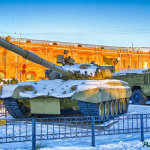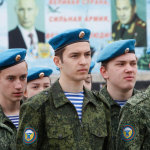‘The Russian man is glad to see death, including his own – it reminds him of the end of everything that exists. He contemplates the ruins and fragments with pleasure…’
This author has watched thirty YouTube videos of Russian soldiers committing suicide. This has been possible thanks to the revolution that has taken place on the battlefield with the proliferation of cheap drones fitted with cameras. One slit his throat. It took him almost a minute to die. Twenty-two shot themselves. Seven killed themselves by detonating grenades: the first held the grenade at arms-length and looked away; the second held the grenade to his chest; the third detonated two grenades against his ears (the head vanished); the fourth also blew his head off; the fifth, a corpulent individual of Asiatic appearance, detonated the grenade under his body armour; the sixth was an individual hiding behind a vehicle wreck; and the seventh held the grenade in front of his face. How many Russian soldiers have committed similar acts unrecorded by Ukrainian drones can only be speculated.
Historically, we might associate such extreme behaviour with the Imperial Japanese Army. More recently we think of the fanaticism of terrorist organisations such as ISIS or Al Qaeda. But we would not normally frame the Russian Army in this way. This article begs the question: is the Russian Army a death cult?
Suicide in Russian culture
In Russia, suicide, or more broadly disdain for life, is modern and rooted in the revolutionary tradition. The most famous suicide is the poet Vladimir Mayakovsy (1893-1930). The cause however was a love affair, not revolution. His funeral was attended by 150,000 people, the largest public mourning event in Bolshevik Moscow after the funerals of Lenin and Stalin.

Rejection of life – as revolutionary act – finds origins in Turgenev’s Fathers and Sons (1862) which popularised the phrase ‘nihilism’ through the character of Bazarov: ‘At the present time negation is the most beneficial of all [acts] –and we deny…everything.’ Nihilism mixed fanatical asceticism with self-mortification. Life mattered little or nothing. Turgenev actually created the character as lampoon of the ‘men of the sixties’, but paradoxically Bazarov became an anti-hero to young Russians seeking change.
The nihilism became violent through the agency of the so-called ‘new men’ – Lenin’s predecessors – the best known of which were Varfolomei Zaitsev (1842-1882), the archetypal nihilist but unknown in the West (and the character of Shigalev in Dostoyesvky’s The Possessed); and Sergey Nechaev (1847–1882) (the character of Pyotr Verkhovensky, also in The Possessed). The ‘Nechaev affair’ was the great cause célèbre in Russia of the period, but also remains completely unknown outside Russia except to Russian historians. The Tsarist authorities were so alarmed by the young man he was gaoled and deliberately starved to death, dying at the age of thirty-five.
Before he died he co-authored with Mikhail Bakunin (1814-1876) one of the most famous tracts of revolutionary literature in world history: The Revolutionary Catechism. It starts with the famous proposition ‘The revolutionary is a lost man…no interests of his own, no affairs of his own, no feelings, no attachments no belongings, not even a name if his own.’ It then goes on to describe a being who ‘despises’, who is ‘hard with himself’, who ‘hates’, and whose object is ‘ruthless destruction’. It could be a description of ‘the Orcs’, as Ukrainians describe the Russians they face on the other side of the trench lines.
While it is undeniable that a life-denying fanaticism coloured Russian revolutionaries (and radicals and anarchists across 19th century Europe), we must still ask, but were the revolutionaries born from a wider Russian cultural substratum that disregarded life, or were they atypical of their society.
Suicide in Russian society
Russian men die young. Roughly one quarter die before the age of 55, mostly due to two causes: tobacco and alcohol (vodka). Average life expectancy for males is 64 years.
Russia also holds the world’s top place for the number of suicides committed by males. In 2020, 16,546 suicides were recorded in Russia. Unemployment, low socioeconomic status, mental illness, and substance abuse are the major risk factors. According to a recent study, cultural influences also make suicidal behaviour ‘socially scripted’ in Russia. Suicide is most prevalent in deprived, rural, indigenous territories – or the very territories where the Russian MOD recruits for Central and Eastern Military District formations (coinciding with Siberian and Far Eastern Federal Districts which record the highest suicide rates in the Russian Federation). The most common method of committing suicide is by firearm, as soldiers on the frontlines perform.
Our souls are Gods, our bodies the Tsar’s
When former Defence Secretary Ben Wallace visited Moscow on the eve of the invasion, Defence Minister Shoigu boasted that nobody could endure as Russians endure. He was reprising a famous Dostoyevskey quote: ‘Our great people were brought up as beasts; they have suffered tortures…tortures such as no other peoples could have endured.’
What Russians have suffered – in the past and today – is absolute, autocratic rule. In the early 19th century, Alexander I tasked his most able state secretary, Mikhail Speransky, to undertake a survey of the governance of the Russian Empire. His account was considered so sensitive it was not declassified until 1961. He wrote: ‘The fundamental principle of Russian government is the autocratic rule… what the government calls Codes and laws are nothing but the arbitrary decisions of the sovereign authority, prescribing to the citizens their duties for a certain period of time i.e. until the autocratic will chooses to change or otherwise circumscribe them.’ The reader will recognise modern Russia in this description. Last year, President Putin signed off 900 decrees, half of which were classified (effectively, common Russians are not even allowed to know what decrees are being passed that govern their lives). The State Duma merely rubber stamps whatever the Kremlin decrees.
This dumb, animal obedience finds its strongest expression in the army. Following the end of WW2, the US Army Historical Division undertook a lengthy study of the Red Army, based on interviews with German officers. ‘Peculiarities of Russian Warfare’ observed:
‘The most common Russian form of combat was the use of mass. Human mass and mass of materiel were generally used unintelligently and without variation, but they were always effective…The Russian disdain for life – always present but now infinitely heightened by Communism – favoured this practice. One must never believe that a Russian attack which has been twice repulsed with unheard-of losses will not be repeated a third and a fourth time at the same place and in the same fashion. Unimpressed by previous failures and losses, new waves always came on…This inflexible method of warfare, with the objective of accomplishing everything through the use of human masses is the most inhuman and costly possible.’

More succinctly, a Ukrainian defender at Avdiivka reported ‘They step on the corpses of their fighters, on the remains of previous assault groups, which are almost never taken away.’ He was little exaggerating: one week after the battle ended, a Russian soldier posted a five minute video walking through the deserted city. He filmed around 30 dead still lying in the streets, many of whom he recognised. In total, as many as 16,000 Russians and separatist militiamen died in the four and a half month battle for Avdiivka, according to a disillusioned Luhansk separatist. This is a greater number of fatalities than the Soviet Army suffered in the ten year war in Afghanistan.

The special case of Wagner PMC
Two days after the final withdrawal of Ukrainian soldiers from the western edge of Bakhmut’s ruins, Prighozin shocked Russians by revealing 10,000 convicts had died in the battle and a comparable number of contracted mercenaries (the journalist who ran the interview was instantly sacked). Since the previous September, Wagner had recruited as many as 50,000 convicts; one in five had died. Prighozin’s arch-rival, the now jailed Igor Strelkov (‘Girkin’) was quick to point out that only 26,000 convicts had been pardoned – where were the missing 14,000? (Prighozin later stated 32,000 were pardoned; even so, a large number were ‘missing’).
A Wagner commander later revealed that a total of 78,000 Wagner mercenaries had in fact fought in Ukraine (of whom 49,000 were convicts). The group had suffered 22,000 killed and 40,000 wounded, or an 80 percent casualty rate and 28 percent killed-in-action rate. Prighozin had told the truth.
A Wagner convict who survived and was demobbed remembered, ‘We were immediately told that for retreating without orders…you would be ‘nullified’ (killed).’ He added, ‘At Wagner we were not recommended to take prisoners…As for us, the fighters of the Wagner PMC, we considered captivity a disgrace: I always had a couple of grenades with me to avoid it as a last resort. Among the Wagnerites, Stalin’s order No. 227 — ‘Not a step back!’ — was strictly in force. As a squad leader, I was authorized to shoot cowards and alarmists if they ran.’ (Ukrainian drone operators have filmed such executions which is why Russian soldiers sprint when they decide to surrender). A total of 137 convicts volunteered from his penal colony. Half died.

Russkiy Mir (‘Russian World’)
Aside from the suicide videos, the author has watched a Russian soldier shoot a (presumably) mortally wounded comrade then rob him. He has also seen a YouTube video in which two Russian soldiers remove the coat of a wounded soldier and leave him to crawl after them on his hands and knees in the snow. He has seen a Russian soldier in a trench set light to the corpse of a comrade, then curl up next to the smouldering body to keep warm. In another instance, a Russian soldier behaving oddly (possibly inebriated or drugged) lay next to the burning body of a comrade struck by an FPV drone; ammunition then exploded and he was killed as well (prompting the Ukrainian drone pilot to remark that he had just won a Darwin Award). He has seen a cat eating the fingers of a dead Russian, and another eating the face of a dead Russian in a trench. He has seen a bird of prey pecking the entrails of a corpse. He has seen a domestic pig feeding on a burnt Russian corpse – pig easting roast human (and somebody’s son). He has seen beatings, and he has seen Russian soldiers stripped naked and made to stand in a pit (‘they will copulate with each other’, a bullying officer joked). All this, it seems, is Russkiy Mir.
Ultimately we cannot interrogate the dead so we can never know why each individual Russian soldier chose a neglected, lonely death in a field in Eastern Ukraine. We can know with some certainty that their president will never trouble himself to view the drone footage recording those deaths.
Sergio Miller
Sergio Miller is a retired British Army Intelligence Corps officer. He was a regular contributor and book reviewer forBritish Army Review. He is the author of a two-part history of the Vietnam War (Osprey/Bloomsbury) and is currently drafting a history of the Russian invasion of Ukraine.





